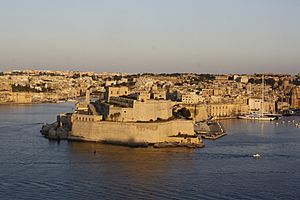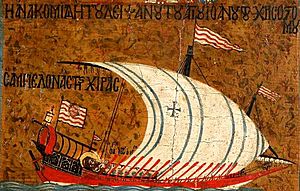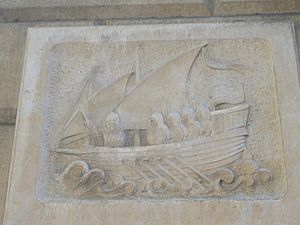Battle of Malta facts for kids
Quick facts for kids Battle of Malta |
|||||||
|---|---|---|---|---|---|---|---|
| Part of War of the Sicilian Vespers | |||||||
 The Castello del Mare (today called Fort Saint Angelo), seen from Valletta. The castle has been changed many times since the 1200s. |
|||||||
|
|||||||
| Belligerents | |||||||
| Commanders and leaders | |||||||
| Roger of Lauria | Guillaume Cornut † Bartholomé Bonvin |
||||||
| Strength | |||||||
| 18–21 galleys 5,500 men |
19–22 galleys 7,800 men |
||||||
| Casualties and losses | |||||||
| 300 men dead 200 men injured |
3,500 men dead 860 men prisoners 10 galleys captured 2 galleys scuttled |
||||||
The Battle of Malta happened on July 8, 1283. It took place at the entrance of the Grand Harbour, which is the main port of Malta. This battle was part of a bigger fight called the War of the Sicilian Vespers.
In this battle, a fleet of ships from Aragon fought against a fleet from the Angevin Kingdom of Naples. The Aragonese ships were led by Roger of Lauria. The Angevin ships were commanded by Guillaume Cornut and Bartholomé Bonvin. Roger of Lauria's fleet won a big victory.
The Angevin ships arrived in Malta first. Their goal was to help the Angevin soldiers who were trapped inside the Castello del Mare castle. The Aragonese fleet followed them closely. Roger of Lauria was very skilled and easily outsmarted the Angevin fleet. He destroyed almost all of their ships. After the battle, Lauria sailed north. He showed off his fleet near Naples, attacked the nearby coast, and took control of the islands of Capri and Ischia. This big defeat forced Charles I of Naples to delay his plans to invade Sicily.
Contents
Why the Battle Happened
In the mid-1200s, the important island of Malta was ruled by the Angevin Kingdom of Sicily. This kingdom was led by Charles I of Anjou. Malta was very important for trade and military control. Both the Angevin Kingdom and the Kingdom of Aragon wanted to control it.
The Sicilian Rebellion
In April 1282, the people of Sicily rebelled against Angevin rule. This rebellion was known as the Sicilian Vespers. After some political discussions, the Sicilian rebels asked Peter III of Aragon to become their king. Peter brought an army to Sicily. By October, the Aragonese and Sicilian forces had pushed the Angevin soldiers out of Sicily.
Because of this, the people of Malta also rebelled in late 1282. They were helped by an Aragonese force. This force was led by Manfred de Lancia, whose brother-in-law was the famous admiral Roger of Lauria. The Angevin soldiers in Malta became trapped inside the Castello del Mare castle. This old castle was located in the Grand Harbour, along with its nearby town of Birgu.
Angevin Plan to Help Malta
Charles of Anjou knew that controlling Malta was key to getting Sicily back. So, he started preparing a navy to help his soldiers in Malta and drive away the Aragonese. However, his fleet had lost many ships in earlier battles. Charles gathered new sailors and ships from his lands in Provence, Narbonne, and Marseille. He put Guillaume Cornut and Bartholome Bonvin in charge of this new fleet. Their plan was to sail to Naples to get more ships, then go to Malta.
In May 1283, twenty-five Angevin ships arrived in Naples from Marseilles. They rested their men there. The two admirals then left Naples with about eighteen galleys, eight or nine smaller ships called barques, and one panfilus. The Angevin fleet sailed around Sicily, avoiding the Strait of Messina, which was controlled by the Aragonese. They sent three small scouting ships ahead to watch the Aragonese fleet. However, these three ships were caught by the Aragonese. This meant the Angevin admirals did not know exactly where the Aragonese fleet was.
The Battle Begins
As the Angevin fleet got close to Malta, the Aragonese soldiers who were attacking the castle moved back to the old city of Citta Notabile. The Angevin fleet, led by Cornut and Bonvin, dropped anchor in the Grand Harbour. They pulled their ships onto the shore along Dockyard creek and placed guard ships at the harbor's entrance.

The Aragonese forces arrived soon after the Angevin fleet. Lauria quickly found out where the Angevin ships were. One Aragonese ship with quiet oars secretly entered the harbor to watch the Angevins. Lauria also likely got information from his scouts on land.
On the morning of July 8, Lauria moved his Aragonese fleet into the Grand Harbour. He ordered his ships to be tied together with heavy chains. This was a clever tactic, first used by the Genoese navy. It stopped enemy ships from breaking through Lauria's line. It also allowed the Aragonese to fire many crossbow bolts at their enemies. Lauria also made sure his ships had enough space for their oars. This way, his fleet could move forward as one unit. In a surprising move, he ordered his fleet to blow trumpets as they arrived. This meant they were not trying a surprise attack. Some historians think Lauria wanted to show off his skill in a fair fight. Others believe it was a trick to make the Angevins leave their safe spot in the harbor.
Fighting in the Harbour
The Angevin fleet did not want to be trapped in the harbor, so they sailed out and got ready for battle. The Angevin admirals thought they only faced 11 enemy ships. They had also gained hundreds of men from the soldiers they had just rescued from the castle. This gave them more fighters, even if they didn't have more ships. Both sides had experienced crews. The Angevins had an advantage with their French-Provençal knights, who were good at close combat. The Aragonese had elite soldiers called almogavars and skilled crossbowmen, making them dangerous from a distance. Aragonese ships also had higher front parts, which protected their crews better from enemy arrows.
The fleets moved towards each other in the Grand Harbour. The fighting started around daybreak. The Angevin forces fired many crossbow bolts and threw lime at the Aragonese. Lauria told his men to take cover on their ships and only fire back with crossbows. By midday, the Angevins had run out of ammunition. So, Lauria ordered his fleet to attack.
At close range, the Aragonese ships fired many crossbow bolts and deadly javelins at the Angevin galleys. This killed many Angevin sailors. With fewer men, the Angevin ships were easily boarded. Ten of them were captured. Seven other Angevin ships, led by Admiral Bovin, managed to get past the Aragonese and escape the harbor. The battle ended at dusk. The Angevin fleet was either scattered or captured by the Aragonese.
Battle Results
The Angevins suffered heavy losses. About 3,500 Angevin soldiers were killed. Another 860 Angevins were captured. Admiral Cornut was reportedly killed in a fight with Lauria. Ten Angevin ships were captured. Of the seven ships that escaped, two had to be sunk later. The Aragonese lost 300 men and had 200 injured. The Aragonese had fewer losses because they were better at fighting from a distance. They also had high morale and better ship designs.

After the Battle
Right after the battle, the Aragonese sent a small ship to Syracuse to announce their victory. The ten captured Angevin ships were added to their fleet. Lauria told the king's officials in the city to send messengers to Messina and the rest of Sicily. A captured Angevin fast ship was quickly prepared and sent to Catalonia, to the King of Aragon. It passed by Mallorca and Barcelona, sending a messenger to tell the Aragonese court the good news.
Admiral Lauria gave up his share of the treasures taken from the enemy. He said that the captured ships and Angevin prisoners were enough. His soldiers thanked Lauria and rested for two days.
Taking Control of Malta
After resting his men, Lauria marched with his flags raised towards the city of Malta. The city leaders asked him not to cause any damage. They said the city would surrender to the King of Aragon and to Lauria. The admiral entered the city with his troops. He received the loyalty of the city and the island. Lauria left 200 men to guard the city against the Angevins who were still in the Castello del Mare. Lauria tried to attack the castle briefly, but he couldn't do it without large siege machines. So, he had to stop the attack.
The leaders of Malta gave Lauria many jewels and precious stones. They also gave him enough supplies for a safe trip to Messina. Then, Lauria sailed to Gozo. He attacked the island and captured its outer defenses. The city of Gozo surrendered right away. It received 100 Catalan soldiers under the same terms as Malta. The people of Gozo gave jewels and more supplies for the Aragonese ships.

The Aragonese fleet then sailed towards Sicily. They landed at Syracuse, then went to Aci and Taormina. The winning fleet was celebrated in every Sicilian port they visited.
What Happened Next
After the victory in Malta, the Aragonese and Sicilians became very good friends. This showed how well they were governed.
This big defeat forced the Angevins to put off their plans to invade Sicily. The battle also showed that the Aragonese navy was very strong. It set the stage for another important battle, the Battle of the Gulf of Naples in 1284. The Aragonese fleet continued to sail north. After showing its strength near Naples and raiding the nearby coast, Lauria attacked and took control of the islands of Capri and Ischia.
Images for kids
-
The Castello del Mare (modern day Fort Saint Angelo), seen from Valletta. The castle has undergone many renovations and re-modellings since the 13th century.
-
Admiral Roger of Lauria, painting by Nicolás Ruiz de Valdivia y Aguilera.
-
A statue of Roger of Lauria in Tarragona, Spain.
-
Bas-relief of medieval galley and sailors, in honour of Roger of Lauria, on the facade of Palau Casades, Barcelona.
See also
 In Spanish: Batalla naval de Malta para niños
In Spanish: Batalla naval de Malta para niños







